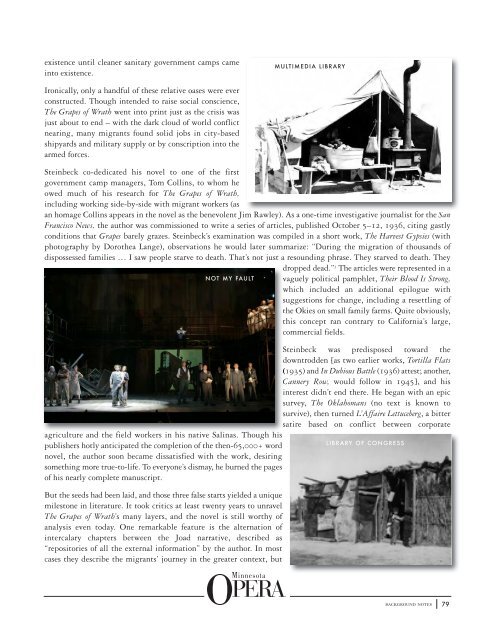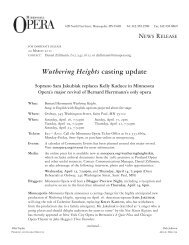You also want an ePaper? Increase the reach of your titles
YUMPU automatically turns print PDFs into web optimized ePapers that Google loves.
existence until cleaner sanitary government camps came<br />
into existence.<br />
MULTIMEDIA LIBRARY<br />
Ironically, only a handful of these relative oases were ever<br />
constructed. Though intended to raise social conscience,<br />
The <strong>Grapes</strong> of Wrath went into print just as the crisis was<br />
just about to end – with the dark cloud of world conflict<br />
nearing, many migrants found solid jobs in city-based<br />
shipyards and military supply or by conscription into the<br />
armed forces.<br />
Steinbeck co-dedicated his novel to one of the first<br />
government camp managers, Tom Collins, to whom he<br />
owed much of his research for The <strong>Grapes</strong> of Wrath,<br />
including working side-by-side with migrant workers (as<br />
an homage Collins appears in the novel as the benevolent Jim Rawley). As a one-time investigative journalist for the San<br />
Francisco News, the author was commissioned to write a series of articles, published October 5–12, 1936, citing gastly<br />
conditions that <strong>Grapes</strong> barely grazes. Steinbeck’s examination was compiled in a short work, The Harvest Gypsies (with<br />
photography by Dorothea Lange), observations he would later summarize: “During the migration of thousands of<br />
dispossessed families … I saw people starve to death. That’s not just a resounding phrase. They starved to death. They<br />
dropped dead.” 3 The articles were represented in a<br />
N OT MY FAULT vaguely political pamphlet, Their Blood Is Strong,<br />
which included an additional epilogue with<br />
suggestions for change, including a resettling of<br />
the Okies on small family farms. Quite obviously,<br />
this concept ran contrary to California’s large,<br />
commercial fields.<br />
Steinbeck was predisposed toward the<br />
downtrodden [as two earlier works, Tortilla Flats<br />
(1935) and In Dubious Battle (1936) attest; another,<br />
Cannery Row, would follow in 1945], and his<br />
interest didn’t end there. He began with an epic<br />
survey, The Oklahomans (no text is known to<br />
survive), then turned L’Affaire Lettuceberg, a bitter<br />
satire based on conflict between corporate<br />
agriculture and the field workers in his native Salinas. Though his<br />
LIBRARY OF CONGRESS<br />
publishers hotly anticipated the completion of the then-65,000+ word<br />
novel, the author soon became dissatisfied with the work, desiring<br />
something more true-to-life. To everyone’s dismay, he burned the pages<br />
of his nearly complete manuscript.<br />
But the seeds had been laid, and those three false starts yielded a unique<br />
milestone in literature. It took critics at least twenty years to unravel<br />
The <strong>Grapes</strong> of Wrath’s many layers, and the novel is still worthy of<br />
analysis even today. One remarkable feature is the alternation of<br />
intercalary chapters between the Joad narrative, described as<br />
“repositories of all the external information” by the author. In most<br />
cases they describe the migrants’ journey in the greater context, but<br />
background notes<br />
79








